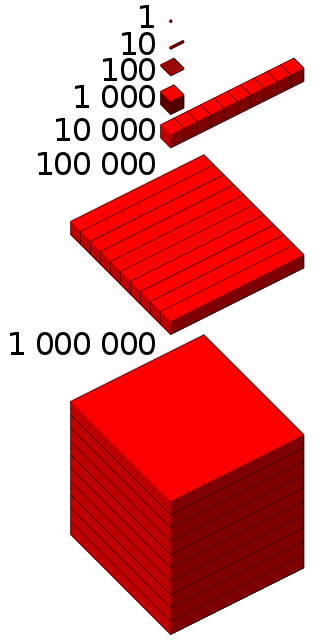Related Research Articles
A palindromic number is a number that remains the same when its digits are reversed. In other words, it has reflectional symmetry across a vertical axis. The term palindromic is derived from palindrome, which refers to a word whose spelling is unchanged when its letters are reversed. The first 30 palindromic numbers are:
19 (nineteen) is the natural number following 18 and preceding 20. It is a prime number.
31 (thirty-one) is the natural number following 30 and preceding 32. It is a prime number.
1000 or one thousand is the natural number following 999 and preceding 1001. In most English-speaking countries, it can be written with or without a comma or sometimes a period separating the thousands digit: 1,000.
300 is the natural number following 299 and preceding 301.
500 is the natural number following 499 and preceding 501.
700 is the natural number following 699 and preceding 701.
It is:
10,000 is the natural number following 9,999 and preceding 10,001.
3000 is the natural number following 2999 and preceding 3001. It is the smallest number requiring thirteen letters in English.
196 is the natural number following 195 and preceding 197.

1,000,000, or one thousand thousand, is the natural number following 999,999 and preceding 1,000,001. The word is derived from the early Italian millione, from mille, "thousand", plus the augmentative suffix -one.
100,000 (one hundred thousand) is the natural number following 99,999 and preceding 100,001. In scientific notation, it is written as 105.
181 is the natural number following 180 and preceding 182.
100,000,000 is the natural number following 99,999,999 and preceding 100,000,001.
In mathematics, a pandigital number is an integer that in a given base has among its significant digits each digit used in the base at least once. For example, 1234567890 is a pandigital number in base 10.
20,000 is the natural number that comes after 19,999 and before 20,001.
50,000 is the natural number that comes after 49,999 and before 50,001.
90,000 is the natural number following 89,999 and preceding 90,001. It is the sum of the cubes of the first 24 positive integers, and is the square of 300.
262 is a natural number preceded by the number 261 and followed by 263. It has the prime factorization 2·131.
References
- ↑ Sloane, N. J. A. Sequences A006072/M4481 in "The On-Line Encyclopedia of Integer Sequences."
- ↑ Weisstein, Eric W. (2002). CRC Concise Encyclopedia of Mathematics (2nd ed.). CRC Press. ISBN 978-1420035223.
- 1 2 "Tetradic Number". Wolfram MathWorld. Retrieved October 28, 2018.
- 1 2 "tetradic number". Everthing2. January 5, 2002. Retrieved October 28, 2018.
- ↑ Sloane, N. J. A. Sequences A068188 in "The On-Line Encyclopedia of Integer Sequences."
- ↑ Caldwell, Chris K. "tetradic prime". The Prime Glossary. The University of Tennessee Martin. Retrieved October 28, 2018.
- ↑ H. Dubner and R. Ondrejka , "A PRIMEr on palindromes," J. Recreational Math., 26:4 (1994) 256–267.
- ↑ R. Ondrejka, "On tetradic or 4-way primes," J. Recreational Math., 21:1 (1989) 21–25.
- ↑ Ondrejka, R. "The Top Ten Prime Numbers" (PDF). The Prime Pages. Retrieved October 28, 2018.
- ↑ Carmody, Phil. "Totally Tetradic!". Fat Phil. Retrieved October 28, 2018.